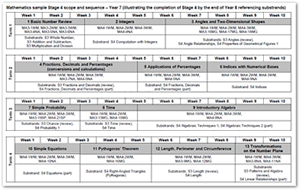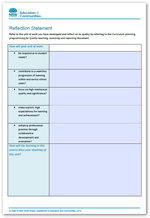Getting started
Courses
|
This course builds on previous courses and it is suggested you may like to engage with these. The learner and the new curriculum provides a focus on diverse learning needs in the 21st century and introduces the new syllabuses. Teaching for the new curriculum assists schools to implement the new curriculum effectively by exploring planning and programming, teaching and assessment practices. Your school and the new syllabuses includes K–10 courses in each of four key learning areas, supporting the introduction of new curriculum in schools by examining each syllabus, analysing needs and formulating implementation plans. |
Lyndall Foster explains the key elements of these professional learning courses.
|
|
More information about all of the courses in this series is available on the NSW syllabuses for the Australian Curriculum: professional learning - Curriculum page accessible through the DEC Portal. |
|
What are my students’ learning needs? How will I meet them?
Students in NSW public schools are entitled to high quality teaching and assessment that is responsive to their learning needs. Click on the arrow to play.
Effective curriculum planning and programming in a school supports teachers to differentiate their practice in response to the varied ways students learn.
Differentiation relates to understanding individual differences and devising teaching strategies to challenge and support every student’s learning. It can occur through adaptations in content, process, product and learning environment.
When planning a unit of learning, you should take into consideration the context and learning needs of students. The course The learner and the new curriculum explores this area in more detail.
The NSW Quality Teaching model is referenced throughout this course.
Scope and sequence
|
After reflecting on the learning needs of your students, it’s time to review your scope and sequence. Scope – the breadth and depth of content to be covered in a curriculum at any one time (e.g. week, term, year, over a student’s school life). All that you do in a given period. Sequence – the order in which content is presented to learners over time. The scope and sequence provides a systematic and explicit plan for building student knowledge, skills and understandings, values and attitudes in each year and stage. A scope and sequence should include:
In addition to syllabus requirements, schools may identify other learning that is appropriate to the local school context and integrate this learning into teaching programs and school activities.
View more sample scope and sequences from the BOS NSW. |
A sample scope and sequence |
What resources are available?
|
Consider the purpose of curriculum planning and programming and the resources available in your school. Explore this further in the course Teaching for the new curriculum. In each of the Your school and the new syllabuses courses participants conducted an audit that involved assessing syllabus requirements, teacher needs, resources and professional learning. This audit will inform the development of the unit of learning required in this course. If you need to revisit these courses see the Professional learning – curriculum page on the NSW syllabuses for the Australian Curriculum website. |
|
Collaboration
Teachers are encouraged to collaborate wherever possible when developing a unit of learning. Curriculum planning and programming aims to enhance professional practice through collaborative development and evaluation. Collaborative development and evaluation of teaching programs ideally occurs at the whole school, stage and year, unit and lesson levels.
|
|
Watch how Glenmore Park High School and Leumeah Public School have begun planning for the new curriculum. |
||
|
|
|
Activity: Reflection Statement
|
|
Complete the reflection statement (.pdf 178kB).
|
Indicative time: 90 minutes
What are these mini-tabs about?
|
Mini-tab |
Indicative time |
What is this mini-tab about? |
|
Courses |
30 minutes |
This mini-tab provides time to reflect on key considerations before you start writing your unit of learning. |
|
My Students |
10 minutes |
This mini-tab focuses on the learning needs of students and introduces the concept of curriculum differentiation. It also considers the context and background of students. To explore this area in more detail see The Learner and the new curriculum. The NSW Quality Teaching model is referenced on this page. You will need to click the button to start the animation. The animation begins by using the quality teaching framework questions and then raises factors that affect students in the classroom. You may restart the animation at any time. A PDF version of this animation is provided on the following pages, for printing. |
|
Scope and sequence |
20 minutes |
This mini-tab explores the key elements of a scope and sequence. |
|
Resources |
10 minutes |
This mini-tab focuses on the audit completed as part of the course Your School and the New Syllabuses that involved assessing syllabus requirements, teacher needs, resources and professional learning. This audit will inform the development of your unit of learning. |
|
Collaboration |
10 minutes |
This mini-tab focuses on how curriculum planning and programming has enhanced professional practice through collaborative development and evaluation. It also explores how different schools have worked collaboratively to produce a unit of learning. |
|
Activity |
10 minutes |
This mini-tab focuses on the scope and sequence you have planned. In light of these considerations, make any changes before proceeding any further. |
Delivery
-
Click to start the animation on the My Students mini-tab and stop whenever you like to discuss content. The diagram provides the opportunity for participants to engage with the four questions and how they relate to planning a unit of learning.
-
Discuss each question.
-
On the Scope and sequence mini-tab click on each expandable for a detailed description.
-
Visit the Board of Studies NSW links for sample scope and sequence plans.
-
Allow participants time to read through the information.
-
Share ideas with the group.
-
On the Resources mini-tab consider the school context featured in Teaching for the new curriculum.
-
Revisit the contents of your audit. Participants may need to revisit one of the Your School and the New Syllabuses courses.
-
On the Collaboration mini-tab, watch how Leumeah Public School and Glenmore Park High School have developed their unit of learning.
-
Refresh your understanding of collaborative planning by reading the information in this tab.
-
On the Activity mini-tab refer to the scope and sequence and make any changes in light of the previous tab.
-
The activity connects with the scope and sequence plan and the unit of learning you are working on.
Completing the activity
This activity provides an opportunity for participants to work individually or as a group.
As a group activity, participants should reflect on their own programs first and complete the questions, then come together to discuss their ideas.





